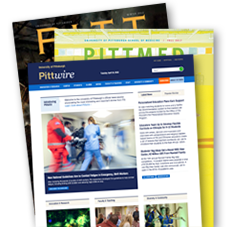Pitt, UMass Launch NSF e-Design Center
PITTSBURGH—Just as the Internet revolutionized advertising and marketing, a new National Science Foundation (NSF) research center based at the University of Pittsburgh and the University of Massachusetts Amherst promises to revolutionize product design by making consumers and manufacturers part of the design process.
The Center for e-Design and Realization of Engineered Products and Systems is an NSF Industry/University Cooperative Research Center, merging the strengths of the two universities with a dozen industry partners. The NSF, member companies, government agencies, and the universities are providing $3 million in cash over the first five years of the project, in addition to contributing in-kind support in the form of personnel, space, software, and hardware to run the center. More universities and companies are expected to join the center as it grows.
"The center will revolutionize the ways products are conceived, designed, realized, and serviced in the world and will spread this new knowledge through programs and training of a new breed of product design engineers," said Bart Nnaji, center director and Alcoa Foundation Professor of Manufacturing Engineering in Pitt's School of Engineering.
According to Nnaji, the center will initially focus on the aerospace, automotive, and medical device industries. A dozen organizations—companies and a government agency—already have agreed to become corporate partners in the center: Wright-Patterson Air Force Research Laboratory, G.E. Aircraft Engine, Alcoa, Ford Motor Company, ANSYS, Respironics, Lockheed Martin, IBM, Pratt & Whitney, Raytheon, BAE Systems, and Parametric Technology.
"It's well established that more than 70 percent of a product's life-cycle costs are committed at the conceptual design phase," said Nnaji. "Industries are now beginning to realize that the best way to reduce life-cycle costs is to evolve a more effective product design paradigm using the Internet and Web-based technologies."
"Continuing the current design processes poses significant risks to our country's long-term competitive advantage," said Janis P. Terpenny, codirector of the center and a professor in the Department of Mechanical and Industrial Engineering at the University of Massachusetts Amherst. "These processes are simply too costly and unacceptable to compete in the fast-paced global marketplace."
Among the most significant problems the e-Design center hopes to ameliorate, Terpenny stated, are development times prolonged by redesign and rework, unacceptably long break-even periods in new design profitability, the recurrence of earlier design problems in later designs, and lost expertise owing to highly mobile careers.
As partners in this new design paradigm, consumers can express their opinions as to what components and features are most useful and important to them, and manufacturers can point out potential problems, suggest ways to reduce costs, or improve the functionality of products.
For example, a consumer might suggest that reducing the weight of a product could improve its performance; a manufacturer could then suggest viable alternative materials with which to assemble the product.
"One of the major issues that industry members usually want to address is being able to assure that proprietary information from all partners—consumers, designers, and manufacturers—are protected, while sharing enough information to make the design viable," said Nnaji. "Fortunately, the National Science Foundation has worked out an acceptable formula for industry over the last 30 years, of setting up such centers of excellence."
###
11/12/03/mgc
Media Resources
Schools of the Health Sciences Media Relations
For more information about Pitt's schools of dental medicine, health and rehabilitation sciences, medicine, nursing, pharmacy, and public health, click here >
To locate stories from health science schools prior to 2013, visit the UPMC news archives »
Urgent Question?
University of Pittsburgh news reps are available to answer urgent media inquiries. Outside of regular business hours (Mon-Fri, 8:30 a.m.-5 p.m.), please email us at media@pitt.edu.
News reps for University of Pittsburgh Health Sciences schools can be reached outside of regular business hours through the paging operator at 1+412-647-2345.


